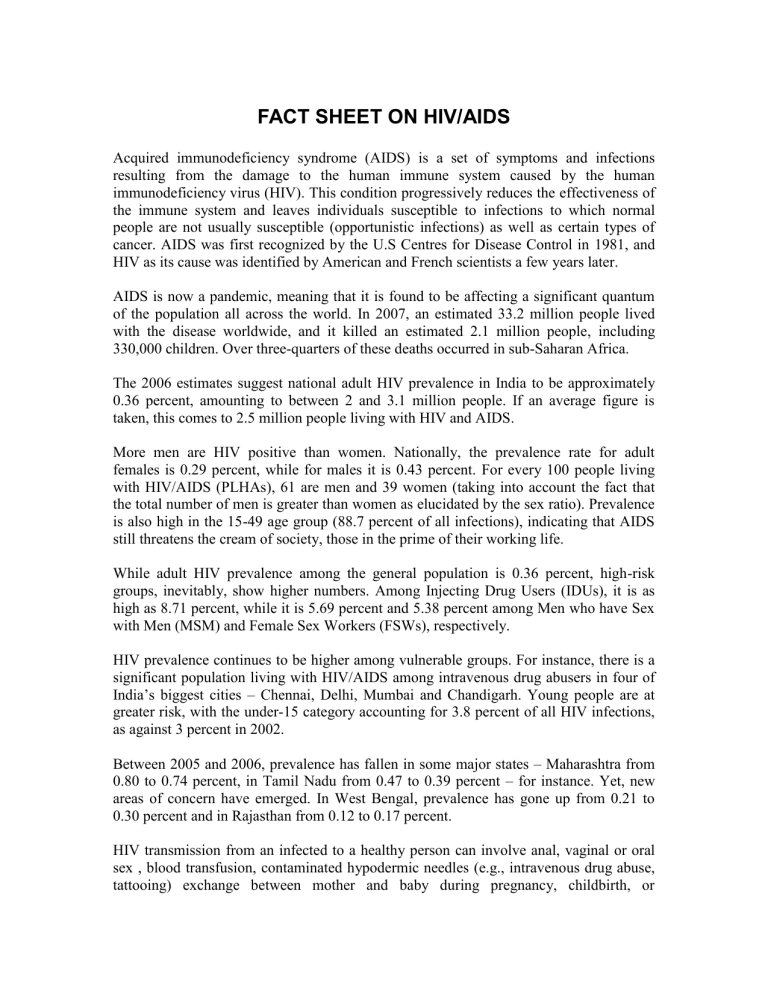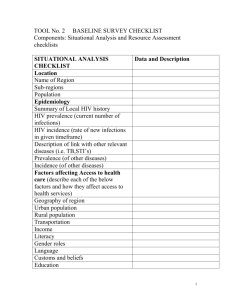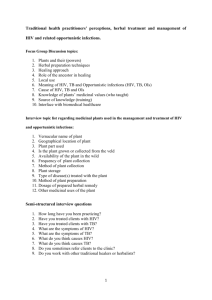FACT SHEET ON HIV/AIDS

FACT SHEET ON HIV/AIDS
Acquired immunodeficiency syndrome (AIDS) is a set of symptoms and infections resulting from the damage to the human immune system caused by the human immunodeficiency virus (HIV). This condition progressively reduces the effectiveness of the immune system and leaves individuals susceptible to infections to which normal people are not usually susceptible (opportunistic infections) as well as certain types of cancer. AIDS was first recognized by the U.S Centres for Disease Control in 1981, and
HIV as its cause was identified by American and French scientists a few years later.
AIDS is now a pandemic, meaning that it is found to be affecting a significant quantum of the population all across the world. In 2007, an estimated 33.2 million people lived with the disease worldwide, and it killed an estimated 2.1 million people, including
330,000 children. Over three-quarters of these deaths occurred in sub-Saharan Africa.
The 2006 estimates suggest national adult HIV prevalence in India to be approximately
0.36 percent, amounting to between 2 and 3.1 million people. If an average figure is taken, this comes to 2.5 million people living with HIV and AIDS.
More men are HIV positive than women. Nationally, the prevalence rate for adult females is 0.29 percent, while for males it is 0.43 percent. For every 100 people living with HIV/AIDS (PLHAs), 61 are men and 39 women (taking into account the fact that the total number of men is greater than women as elucidated by the sex ratio). Prevalence is also high in the 15-49 age group (88.7 percent of all infections), indicating that AIDS still threatens the cream of society, those in the prime of their working life.
While adult HIV prevalence among the general population is 0.36 percent, high-risk groups, inevitably, show higher numbers. Among Injecting Drug Users (IDUs), it is as high as 8.71 percent, while it is 5.69 percent and 5.38 percent among Men who have Sex with Men (MSM) and Female Sex Workers (FSWs), respectively.
HIV prevalence continues to be higher among vulnerable groups. For instance, there is a significant population living with HIV/AIDS among intravenous drug abusers in four of
India’s biggest cities – Chennai, Delhi, Mumbai and Chandigarh. Young people are at greater risk, with the under-15 category accounting for 3.8 percent of all HIV infections, as against 3 percent in 2002.
Between 2005 and 2006, prevalence has fallen in some major states – Maharashtra from
0.80 to 0.74 percent, in Tamil Nadu from 0.47 to 0.39 percent – for instance. Yet, new areas of concern have emerged. In West Bengal, prevalence has gone up from 0.21 to
0.30 percent and in Rajasthan from 0.12 to 0.17 percent.
HIV transmission from an infected to a healthy person can involve anal, vaginal or oral sex , blood transfusion, contaminated hypodermic needles (e.g., intravenous drug abuse, tattooing) exchange between mother and baby during pregnancy, childbirth, or
breastfeeding, or other exposure to one of the above body fluids. Heterosexual contact has taken over from homosexual contact as the most common route of transmission, but the mode of transmission most likely to cause infection following single contact is via infected blood transfusion. Following infection a person soon becomes infective to others and remains so for the rest of his/her life. However, infection can spread only via the aforementioned body fluids and not via casual contact like handshakes, coughing and sneezing etc. Though HIV is found in saliva, yet kissing is not considered to be a mode of transmission.
There is a difference between HIV infection and AIDS. Following infection, HIV begins to progressively weaken the immune system, basically by causing the depletion of a certain type of cells known as CD4 lymphocytes that are essential for fighting off infections, leading to gradual waning of the immune function, but it can take anywhere between 5 to 10 years before full blown AIDS is manifest in the form of severe immunocompromized state and opportunistic infections. However, it is not as if AIDS patients get only opportunistic infections; they are also more susceptible to the usual infectious diseases affecting normal people around them and these infections become harder to treat due to the weakened immune function.
HIV affects nearly every organ system. People with AIDS also have an increased risk of developing various cancers such as Kaposi's sarcoma, cervical cancer and cancers of the immune system known as lymphomas. Additionally, people with AIDS often have systemic symptoms of infection like fevers, sweats (particularly at night), swollen glands, chills, weakness, and weight loss. The specific opportunistic infections that AIDS patients develop depend in part on the prevalence of these infections in the geographic area in which the patient lives. Common infections include pneumonia, infections of the membranes covering the brain, fungal infections of the mouth, food pipe and airways, herpes, and persistent diarrhea that can be due to a variety of infectious agents. Also seen is toxoplasmosis that is often asymptomatic in the patient but can be transmitted from the mother to the unborn child leading to blindness and other severe developmental abnormalities.
Diagnosis of HIV infection is via blood tests to detect either antibodies formed in response to specific components of the HIV or the viral genetic material by using
Polymerase Chain Reaction (PCR) technique to amplify it to detectable levels, or levels of viral protein components by using the test known as Western Blot. The tests involving antibody detection are cheaper and more practical, but become positive some time after infection (depending on the initial infecting viral load), and become negative for upto 6 months before becoming positive again, then finally decline as the patient’s immune system gets progressively compromised. There is also the problem of false positives and false negatives. For this reason a single positive test has no value, at least two positive results using different methods indicate HIV infection. The other modes of diagnosis being expensive and slower are used in India only for confirmation in case of doubt, and for research purposes.
In children born to mothers with HIV infection the maternal antiviral antibodies cross the placenta and lead to false positive results if antibody tests are used. To diagnose HIV in such children PCR is required. A very low percentage of such children turn out to actually have HIV infection.
As mentioned previously, diagnosis of HIV infection is not synonymous with diagnosis of AIDS, which involves documentation of specific opportunistic infections in a person with diagnosed HIV infection.
There is currently no treatment available for HIV/AIDS. The drugs against the HIV
(called antiretroviral drugs) can suppress HIV multiplication in the body thus preserving the immune function for some time, but can’t cure it. If given to a pregnant woman they can control the chances of transmission to the unborn child, and can reduce chances of development of HIV infection following contact with infected body fluids as in healthcare settings, but are do not provide gilded guarantees in any such situation. The obvious method to protect oneself from this deadly disease is preventing contact with potential sources of infection. This means monogamous relationships, protected intercourse using condoms(which provide the extra benefits of birth control and prevention of other sexually transmitted diseases), avoiding intravenous drug abuse and getting injections (including tattoos) in any place where there is the slightest suspicion of lack of adherence to the rule of using one needle for one patient only.






